
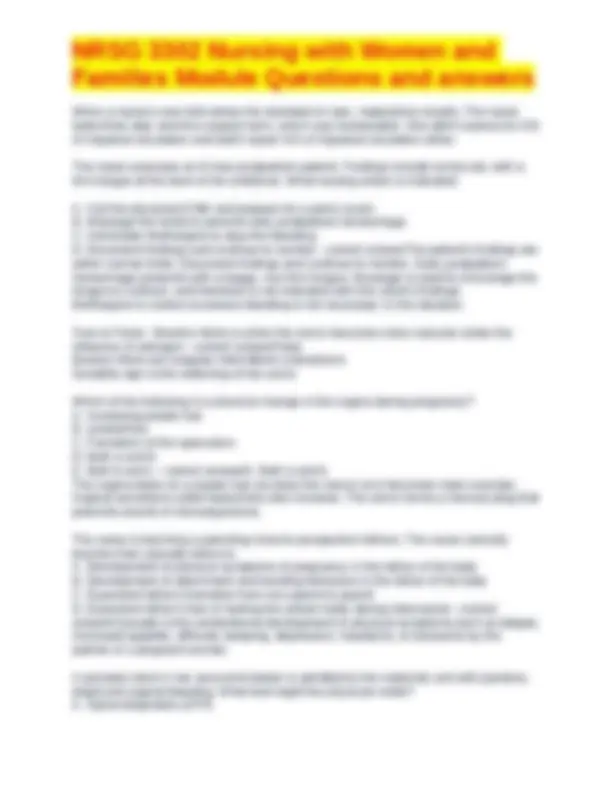
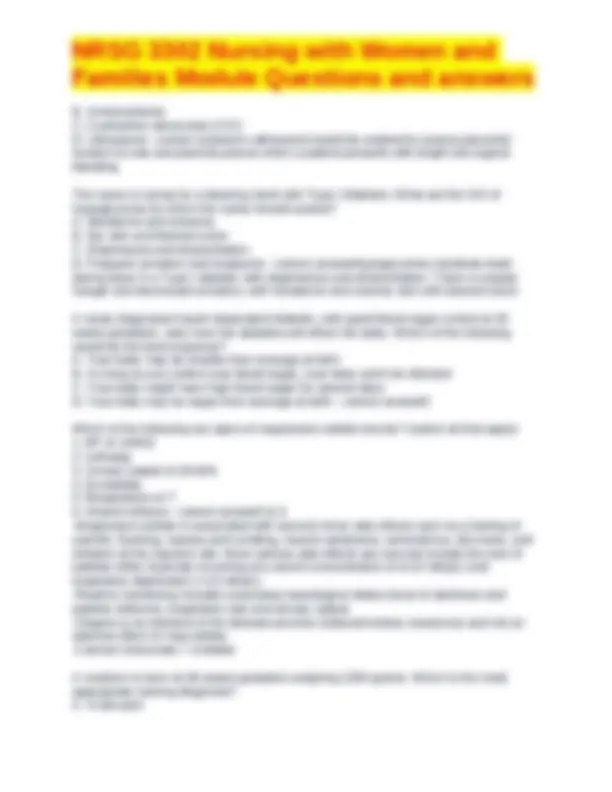
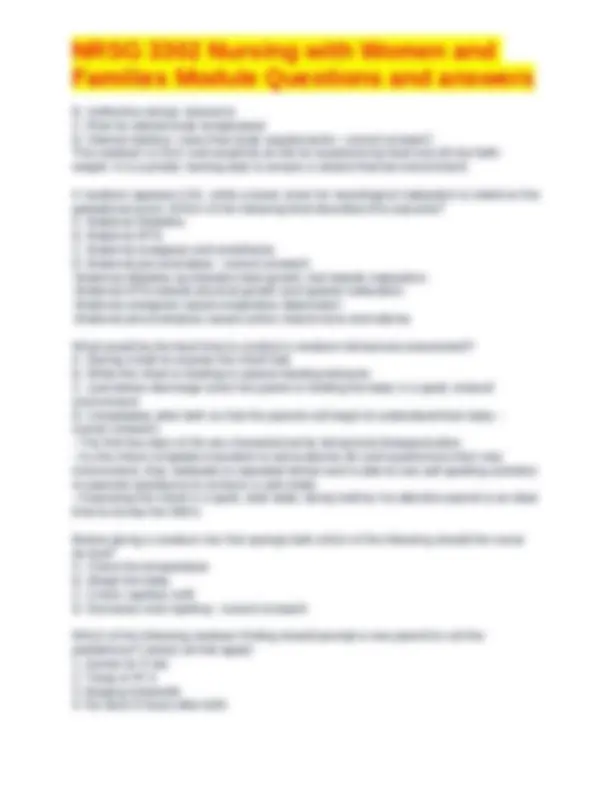
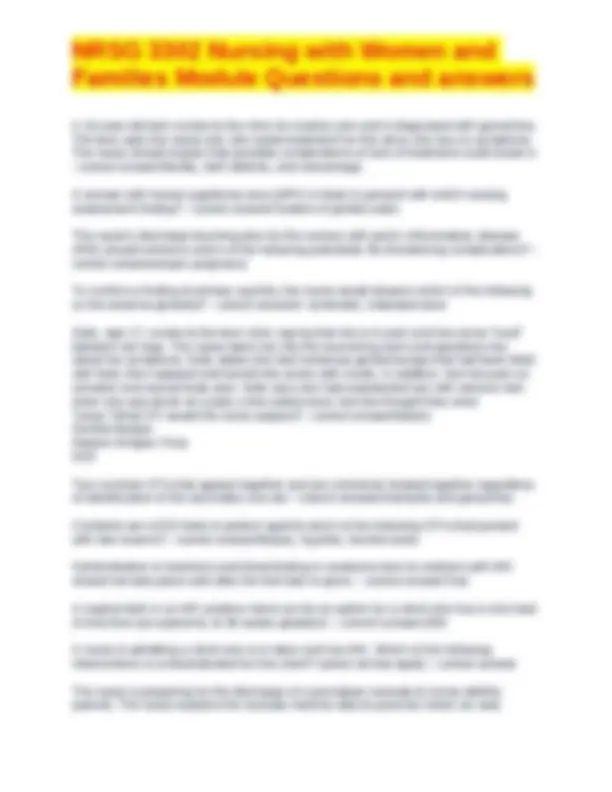
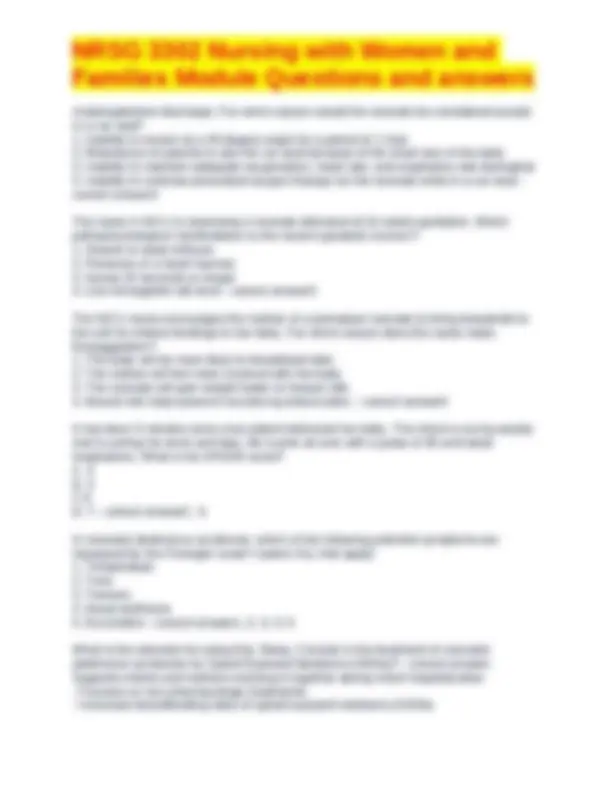
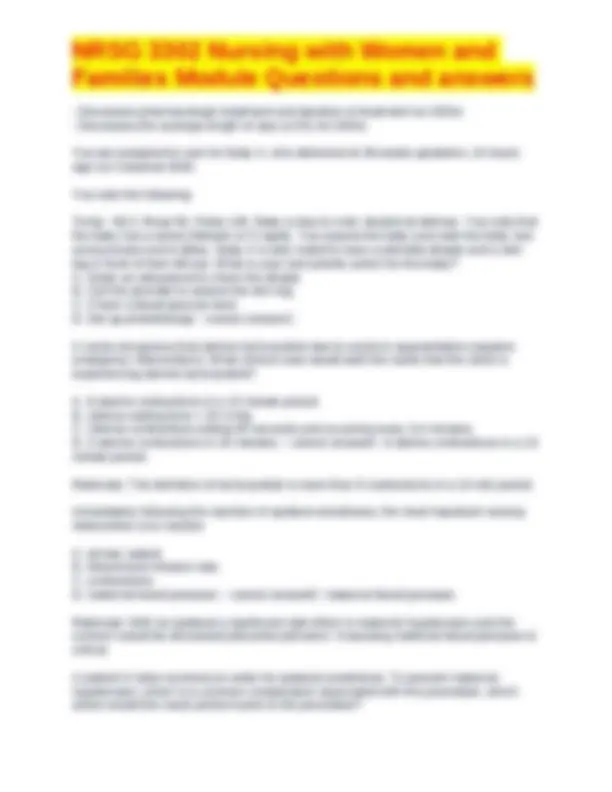
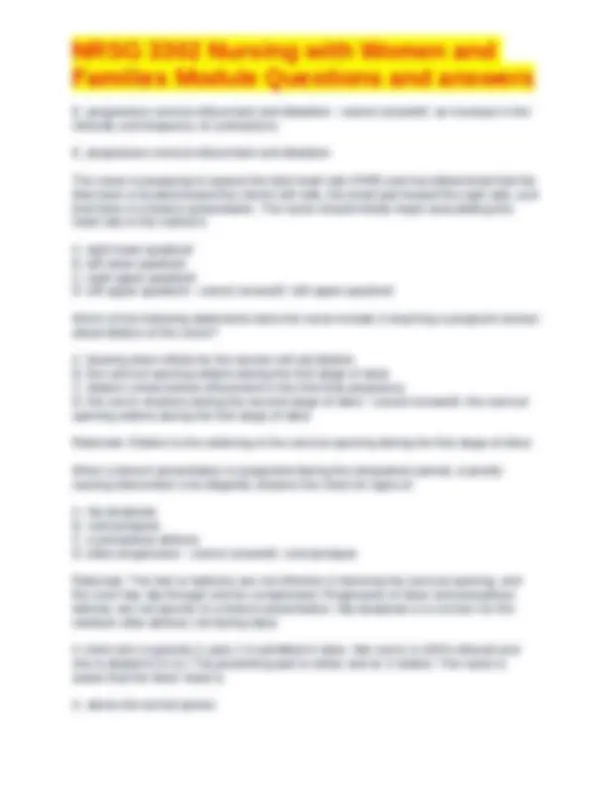
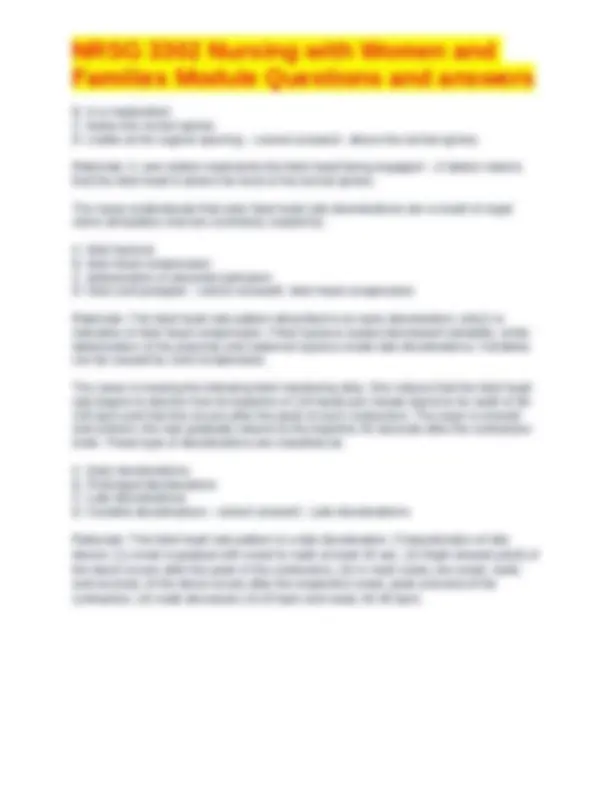


Study with the several resources on Docsity

Earn points by helping other students or get them with a premium plan


Prepare for your exams
Study with the several resources on Docsity

Earn points to download
Earn points by helping other students or get them with a premium plan
Community
Ask the community for help and clear up your study doubts
Discover the best universities in your country according to Docsity users
Free resources
Download our free guides on studying techniques, anxiety management strategies, and thesis advice from Docsity tutors
NRSG 3302 Nursing with Women and Families Module Questions and answers NRSG 3302 Nursing with Women and Families Module Questions and answers
Typology: Exams
1 / 14

This page cannot be seen from the preview
Don't miss anything!









Which of the following functions are included in the Nurse Practice Act (NPA) (Select all that apply)
children or unconscious or mentally incompetent people must a family member be aware of the procedure. The document protects the surgeon and the health care facility in that it indicates that the patient knows and understands all aspects of the procedure. -An emancipated minor is one who is legally under the age of majority (in most states this is 18 years) but is recognized as having the legal capacity of an adult under circumstances prescribed by state law such as pregnancy, miscarriage, high school graduation, independent living or military service. -Additionally, females younger than the age of consent are able to legally give informed consent when they are minor parents, emancipated or adolescents seeking birth control, mental health treatment, or substance abuse treatment. Nurses in the perinatal setting should be familiar with the laws of their state regarding a minor's ability to give informed consent. A woman has decided to abort her pregnancy. Although the nurse disagrees with abortion, the nurse recognizes the client is competent and supports the client's decision using which ethical principle? A. Justice B. Fidelity C. Autonomy D. Confidentiality - correct answerC. Autonomy Autonomy refers to the right to make one's own decision which is the principle supported in this situation You are a nurse in the ER caring for an 18 year old with a fractured leg. The physician applied the cast with insufficient padding. The man's toes became swollen and discolored and he developed decreased sensation. You recognize these S/S of impaired circulation and call the physician repeatedly but do not connect with him. The 18 year old develops gangrene and his leg must be amputated Do you think the nurse is liable in this case? - correct answerThe nurse would be liable for failing to adhere to the standards of care for monitoring and reporting the patient's symptoms. even though she called multiple times, the nurse should have gone over the physician's head to make sure that the patient is appropriately treated. She should have called the supervisor.
B. Amniocentesis C. Contraction stress test (CST) D. Ultrasound - correct answerAn ultrasound would be ordered to assess placental location to rule out placenta prevue when a patient presents with bright red vaginal bleeding The nurse is caring for a laboring client with Type I diabetes. What are the S/S of hypoglycemia for which the nurse should assess? A. Headache and anorexia B. Dry skin and blurred vision C. Diaphoresis and disorientation D. Frequent urination and headache - correct answerHypoglycemia manifests itself during labor in a Type I diabetic with diaphoresis and disorientation. There is usually hunger and decreased urination, with headache and clammy skin with blurred vision. A newly diagnosed insulin dependent diabetic, with good blood sugar control at 20 weeks gestation, asks how her diabetes will affect her baby. Which of the following would be the best response? A. Your baby may be smaller than average at birth B. As long as you control your blood sugar, your baby won't be affected C. Your baby might have high blood sugar for several days D. Your baby may be larger than average at birth - correct answerD Which of the following are signs of magnesium sulfate toxicity? (select all that apply)
B. Ineffective airway clearance C. Risk for altered body temperature D. Altered nutrition: more than body requirements - correct answerC. This newborn is SGA and would be at risk for experiencing heat loss d/t low birth weight. It is a priority nursing duty to ensure a neutral thermal environment. A newborn appears LGA, while a lower score for neurological maturation is noted on the gestational exam. Which of the following best describes this outcome? A. Maternal Diabetes B. Maternal HTN C. Maternal analgesia and anesthesia D. Maternal pre-eclampsia - correct answerA. -Maternal diabetes accelerates fetal growth, but retards maturation. -Maternal HTN retards physical growth and speeds maturation. -Maternal analgesia causes respiratory depression. -Maternal pre-eclampsia causes active muscle tone and edema. What would be the best time to conduct a newborn behavioral assessment? A. During a bath to expose the infant fully B. While the infant is feeding to assess feeding behavior C. Just before discharge when the parent is holding the baby in a quiet, relaxed environment D. Immediately after birth so that the parents will begin to understand their baby - correct answerC.
When a new mom asks you how to stimulate let-down, what would you say? A. Lullaby music B. Maternal thoughts of the infant C. Eliciting the palmar grasp reflex D. Changing a diaper - correct answerB What is the MOST IMPORTANT reason for breastfeeding beyond a baby's first year of life? A. Muscular development of the jaw and mouth B. Nutrition and trace minerals C. Immune protection tailored to the child's environment D. Emotional attachment between mother and child - correct answerC. 1-day-old Baby You is 7 lbs 8 oz (3400 g) at 39 2/7 weeks. Your assessment reveals him to be cold and jittery. His mother is healthy with no medical issues. What should your priority concern be? A. IUGR B. Hypoglycemia C. Hyperbilirubinemia D. SGA - correct answerB A nurse wants to describe physiologic jaundice in the most accurate and helpful way to the parents. Which of the following descriptions should she use: A. "It is considered a normal process that occurs during transition from intrauterine to extrauterine life, and appears after 24 hours of life" B. "Jaundice is considered an abnormal process that occurs during transition from intrauterine to extrauterine life and appears before 24 hours of life" C. "There is no statistical difference between breastfed and bottle-fed babies regarding bilirubin levels" D. "Jaundice usually stays visible for 20-25 days" - correct answerA The highest priority nursing diagnosis for a neonate experiencing RDS is: A. Acute pain B. Alterations in parenting C. Impaired gas exchange, r/t inadequate lung surfactant D. Altered nutrition: more than body requirements - correct answerC. A nurse in a health clinic is reviewing contraceptive use with a group. Which of the following client statements demonstrates understanding? - correct answer"A contraceptive patch is removed after three weeks" Which of the following manifestations should a client taking oral contraceptives report to the provider? - correct answerPain, redness and warmth in the calf
A 16-year-old teen comes to the clinic for routine care and is diagnosed with gonorrhea. The teen asks the nurse why she needs treatment for this since she has no symptoms. The nurse should explain that possible complications of lack of treatment could result in
A. Teach the patient controlled breathing techniques. B. Administer an amnioinfusion to ensure fetal heart rate variability. C. Place the patient in a left lateral position. D. Administer 500-1000 ml of intravenous fluids. - correct answerD. Administer 500- 1000 ml of intravenous fluids. Rationale: Administering a fluid bolus prior to an epidural generally prevents maternal hypotension, which is the most common complication associated with the procedure. An amnioinfusion may correct variability but it it does not prevent maternal hypotension. The patient's position may alter her BP but is not the priority preventative measure. Breathing techniques are used to help avoid the need for analgesia. Your G3 P0 patient at 40-weeks gestation is having a prolonged, painful, and anxiety- filled labor. The patient is finally diagnosed with cephalopelvic disproportion (CPD). The nurse should stop and question which of the following contradictory medical orders? A. Administer narcotic analgesics as ordered B. Record fetal heart tones every 15-30 minutes C. Add 10 units of oxytocin to IV fluids to augment labor contractions D.Maintain NPO status - correct answerC. Add 10 units of oxytocin to IV fluids to augment labor contractions Rationale: When cephalopelvic disproportion is diagnosed, a cesarean birth is indicated; infusing oxytocin at this time could result in fetal compromise and uterine rupture Assessment of a primigravida client in labor who has had no analgesia or anesthesia reveals complete (100%) cervical effacement, dilation of 8 cm, and the fetus at 0 station. The nurse should expect the client to exhibit which behavior during this phase of labor? A. feelings of relief B. loss of control C. excitement D. numbness of legs - correct answerB. loss of control Rationale: The transition phase begins with 8 cm of dilatation, and is characterized by contractions that are closer and more intense. A woman is admitted in labor. She is 6 cm dilated, -2 station, with intact membranes. Her membranes rupture spontaneously. What would the nurse's initial response be? A. notify the physician B. administer oxygen at two liters per minute
E. progressive cervical effacement and dilatation - correct answerD. an increase in the intensity and frequency of contractions E. progressive cervical effacement and dilatation The nurse is preparing to assess the fetal heart rate (FHR) and has determined that the fetal back is located toward the client's left side, the small part toward the right side, and that there is a breech presentation. The nurse should initially begin auscultating the heart rate in the mother's: A. right lower quadrant B. left lower quadrant C. right upper quadrant D. left upper quadrant - correct answerD. left upper quadrant Which of the following statements does the nurse include in teaching a pregnant woman about dilation of the cervix? A. bearing down efforts by the woman will aid dilation B. the cervical opening widens during the first stage of labor C. dilation comes before effacement in the first time pregnancy D. the cervix shortens during the second stage of labor - correct answerB. the cervical opening widens during the first stage of labor Rationale: Dilation is the widening of the cervical opening during the first stage of labor. When a breech presentation is suspected during the intrapartum period, a priority nursing intervention is to diligently observe the client for signs of: A. hip dysplasia B. cord prolapse C. a precipitous delivery D. labor progression - correct answerB. cord prolapse Rationale: The feet or buttocks are not effective in blocking the cervical opening, and the cord may slip through and be compressed. Progression of labor and precipitous delivery are not specific to a breech presentation. Hip dysplasia is a concern for the newborn after delivery not during labor. A client who is gravida 2, para 1 is admitted in labor. Her cervix is 100% effaced and she is dilated to 6 cm. The presenting part is vertex and at -2 station. The nurse is aware that the fetus' head is: A. above the ischial spines.
B. in a malposition. C. below the ischial spines. D. visible at the vaginal opening. - correct answerA. above the ischial spines. Rationale: A zero station represents the fetal head being engaged - -2 station means that the fetal head is above the level of the ischial spines. The nurse understands that early fetal heart rate decelerations are a result of vagal nerve stimulation and are commonly caused by: A. fetal hypoxia B. fetal head compression C. deterioration of placental perfusion D. fetal cord prolapse - correct answerB. fetal head compression Rationale: The fetal heart rate pattern described is an early deceleration, which is indicative of fetal head compression. Fetal hypoxia causes decreased variability, while deterioration of the placenta and maternal hypoxia create late decelerations. Variables can be caused by cord compression. The nurse is viewing the following fetal monitoring strip. She notices that the fetal heart rate begins to decline from its baseline of 120 beats per minute (bpm) to its nadir of 90- 100 bpm and that this occurs after the peak of each contraction. The wave is smooth and uniform; the rate gradually returns to the baseline 40 seconds after the contraction ends. These type of decelerations are classified as: A. Early decelerations B. Prolonged decelerations C. Late decelerations D. Variable decelerations - correct answerC. Late decelerations Rationale: This fetal heart rate pattern is a late deceleration. Characteristics of late decels: (1) onset is gradual with onset to nadir at least 30 sec, (2) Nadir (lowest point) of the decal occurs after the peak of the contraction, (3) in most cases, the onset, nadir, and recovery of the decal occurs after the respective onset, peak and end of the contraction, (4) nadir decreases 10-20 bpm and rarely 30-40 bpm.